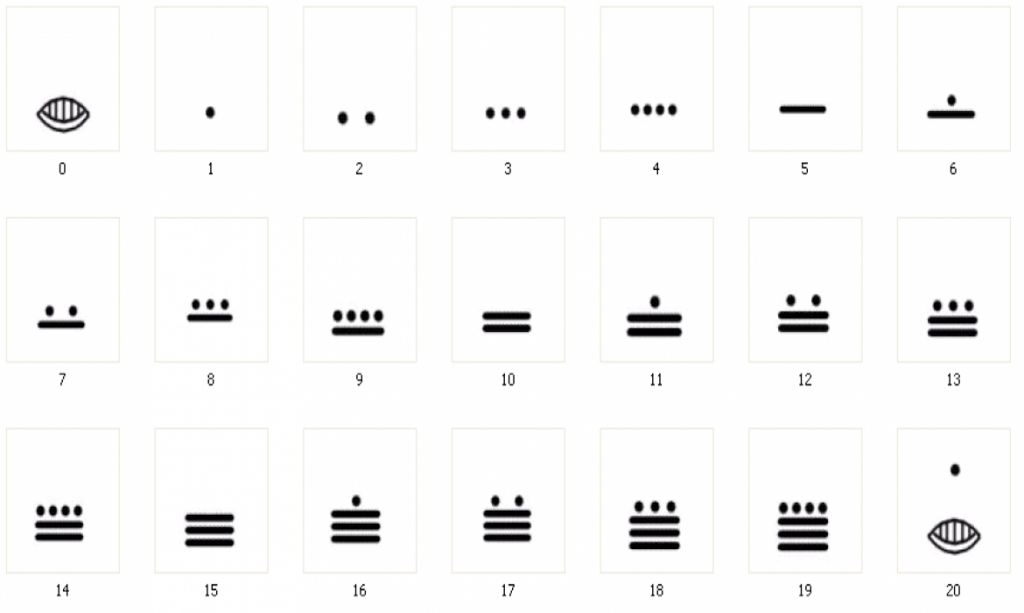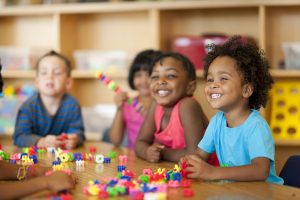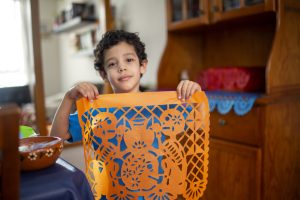- The Mayans used a base 20 numeral system that can help young children learn patterns, counting, and other math concepts.
- Download the fun and free printable, Doing Math the Mayan Way.
- Children gain foundational math skills through activities that are steeped in cultural beliefs.
When we hear the word math, what do we think about? We might think about numbers, addition and subtraction, classroom lessons, academic success, and perhaps very difficult problem-solving tasks. But there is something missing from the equation: when we hear the word math, do we think about our homes and communities?
Math Beyond the Classroom
When it comes to math, there is a lot happening outside the classroom. There are many ways in which families engage with young children around math at home, including activities such as block play, cooking, and technology. The home environment is not the only important site for learning math. Other spaces include libraries and cultural communities. These venues offer formal programs and informal opportunities that nurture early math concepts, such as numeracy, shapes, patterns, and space.
When we hear the word math, do we think about culture? In general, math teaching and learning are not associated with what we do in our homes, with family and friends, or outside of school. Cultural aspects of math are even more overlooked within these non-academic learning spaces.
Children gain foundational math skills in their homes and communities, particularly through activities that are steeped in cultural beliefs and traditions. [1] The home is often the site where we learn about the beliefs, practices, and traditions that make up our culture. The activities and traditions practiced at home are integral to the ways in which young children begin to learn math.
Math and Mayan Culture

Research studies help illustrate how math and culture are related to one another. For example, a study of an autonomous rural Mayan community in Chiapas, Mexico, showed how residents weaved maguey bags (made from the fibers of maguey, or agave, plants) using a complex system involving counting with a base 20 to form different patterns and designs. [2] Young children from the community learned how to make these woven bags from their parents and grandparents. In this way, the practice was passed down from generation to generation and had both economic and cultural functions: to maintain a tradition and to support the family business.
Children learned about counting, patterns and sequences, and money management within a culturally rich setting that capitalized on the importance of preserving tradition. Children participated in their parents’ and grandparents’ businesses by helping them shop, translate words, and calculate numbers. By teaching their children how to make maguey bags, the experience of engaging in a culturally valued practice also served to strengthen the children’s ties to their community and their sense of Mayan identity.
Cooking Together

There are other sites of learning where we find connections between math and culture. For example, Latino caregivers regularly allow or encourage their children to help them during cooking, suggesting that this activity may be prevalent in Latino homes. [3] Home practices, such as cooking regional dishes, lend themselves to the use of math. During cooking time, children can practice their numeracy and measurement skills by counting the number of chocolate chips or measuring the amount of water they need to mix in a cookie batter.
Cooking together also provides opportunities for Latino parents to activate cultural strategies for supporting their child’s education, including familism (familismo), proper behavior (bien educado), and respectfulness towards adults and superiors (respeto). The interaction between Latino parents’ native cultural values and practices and those of the dominant culture they are adapting to is complex. This relationship between different cultural values influences how they socialize their children’s math and other school learning. [4]
Understanding the cultural differences in these perceptions and practices surrounding math learning is important for creating inclusive, context-rich teaching strategies both in and outside of the classroom. Parents and caregivers are already doing activities with their children that support early math skills. These activities are rooted in cultural traditions or informed by cultural attitudes. By incorporating the cultural components of math in academic and everyday activities with small children, we can find new learning opportunities.
Doing Math the Mayan Way

Our activity, Doing Math the Mayan Way, encourages parents and teachers to teach children how to count using the Mayan numeral system. As with the counting system used by families to make maguey bags, the Mayans used a base 20 counting system. Our activityemphasizes the complexity and uniqueness of this number system, pointing out details important to the cultural background of the practice—among them, the fact that Mayans were the first to use the number zero in a numerical system.
Doing Math the Mayan Way guides parents to teach children how to count using materials they might already have at home, such as beans, sticks, and paper. The activity seeks to engage parents and children in early math concepts, such as numeracy and operations. The instructional setup is inviting for young children, with colorful materials that support mathematical thinking and fine motor skills.
Why Do Math the Mayan Way?
The Mayan counting system provides a rich opportunity for children to learn about math and a new culture. It is one example of the ways in which math and culture are intertwined and can be used as a tool for supporting early math in and outside of the classroom.
We believe that culture is an important component of the conceptual fabric of math learning. Activities such as this one strive to honor Mayan culture and highlight the different ways in which the group conceptualized and practiced mathematics. By teaching children to count the Mayan way, we are not only capitalizing on cultural practices that nurture early math learning beyond the classroom, but also we are starting to instill in children a sense of cultural sensitivity, competence, and curiosity.
Our goal is to expand our notions of and possibilities for how children learn math at a very young age, investigating cultural differences in these processes, and continuing to ask ourselves as we move forward: when we hear the word math, what do we think about?
[1] Sonnenschein, S., Galindo, C., Simons, C. L., Metzger, S. R., Thompson, J. A., & Chung, M. F. (2018). How Do Children Learn Mathematics? Chinese and Latina Immigrant Perspectives. In Chuang, S. S., & Costigan, C. L. (Eds.), Parental Roles and Relationships in Immigrant Families (pp. 111-128). New York, NY: Springer.
[2] Hirsch-Dubin, F. P. (2009). Mayan Elders, Mayan mathematics, and the weaving of resistance in Maguey Bag Production. Journal of Mathematics and Culture, 4(1), 63-83.
[3] Based on preliminary results from a study being conducted by the authors.
[4] Galindo, C., Sonnenschein, S., & Montoya-Ávila, A. (2019). Latina mothers’ engagement in children’s math learning in the early school years: Conceptions of math and socialization practices. Early Childhood Research Quarterly, 47, 271-283.



